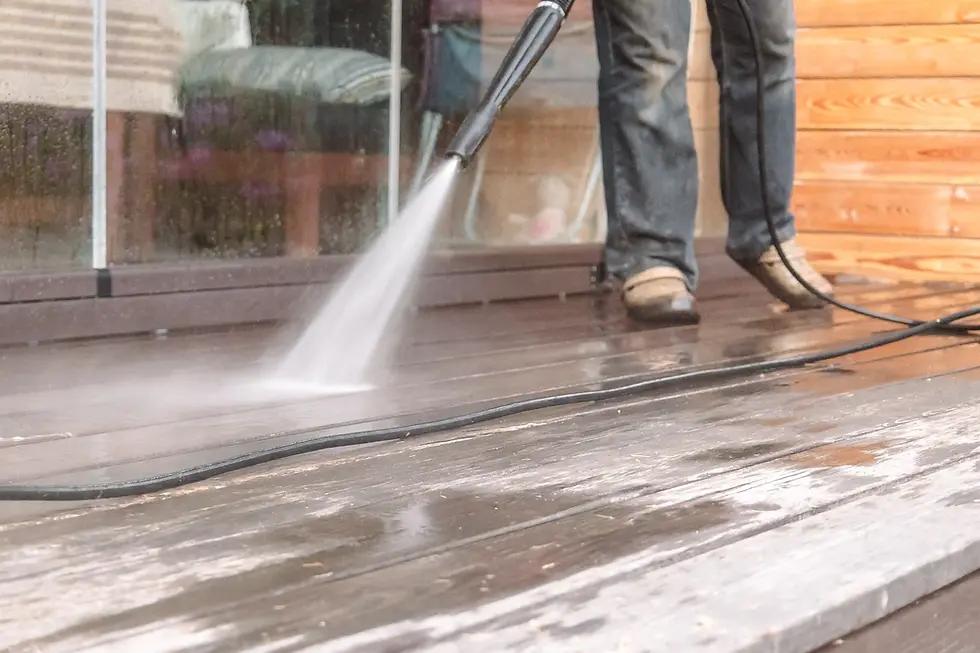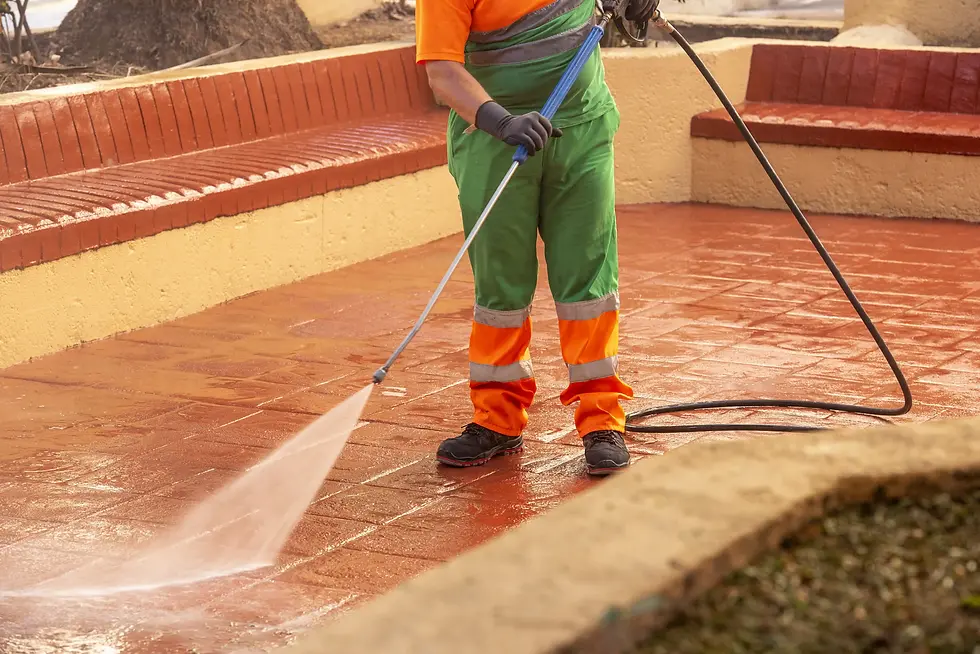Pressure Washing a Deck: The Dos & Don’ts
- andreyen
- 5 days ago
- 4 min read
(Ultimate Guide for New Jersey Homeowners)
Your deck is more than just a few planks of wood—it’s where family barbecues happen, where you sip morning coffee, and where kids (or grandkids) chase fireflies in the summer. But over time, grime, mildew, and weather can dull its beauty.
That’s when many homeowners ask: “Can’t I just pressure wash it?”
Yes—you can. But here’s the catch: done wrong, pressure washing can damage your deck beyond repair. Done right, it can restore your deck’s beauty and extend its lifespan.
At Burrini’s Powerwashing, we’ve seen both sides: gorgeous transformations and heartbreaking mistakes. That’s why we created this comprehensive guide on the dos and don’ts of pressure washing your deck—so you don’t learn the hard way.

1. Understanding Deck Cleaning & Pressure Washing Basics
Pressure Washing vs. Power Washing Let’s clear this up first. Pressure washing uses high-pressure water to blast away dirt. Power washing is similar, but it adds heated water—better for grease and oil stains, but often too aggressive for wood decks.
When Should You Pressure Wash a Deck?
If your deck looks grey, stained, or has mildew spots.
Before applying a new coat of stain or sealant.
After a harsh New Jersey winter (snow, ice, and salt residue).
When Not to Pressure Wash
On rotting or splintered wood (pressure makes it worse).
In freezing temps or direct summer sun (wood expands/contracts).
On warranty-sensitive composite decks (check manufacturer guidelines).
Different Deck Materials Need Different Care
Softwoods (pine, cedar): Lower PSI to avoid gouging.
Hardwoods (mahogany, ipe): Can handle slightly higher pressure.
Composite decking: Often needs special cleaning solutions, not brute force.
2. Preparation Before You Begin
We always say: a great wash starts with great prep.
Safety First: Wear goggles, gloves, and non-slip shoes. A pressure washer can send debris flying.
Inspect Your Deck: Loose boards, rusty nails, or cracks? Fix those first.
Clear the Area: Move furniture, grills, and planters. Trust us—you don’t want to blast dirt onto your outdoor sofa.
Protect Surroundings: Cover nearby plants and windows. A mis-aimed spray can shred leaves or crack glass.
Sweep & Pre-clean: Get rid of leaves and dirt so your washer doesn’t just spread the mess.
Choose the Right Time: Mild, dry days in spring or early fall are best in New Jersey.
3. Equipment & Materials — What You’ll Need
Walking into a hardware store can feel overwhelming. Here’s the simplified list:
Pressure Washer: Electric models work for small decks; gas-powered ones give more punch.
Nozzles / Spray Tips: Use a 25° or 40° nozzle. Skip the 0° tip—it’s like a knife.
PSI Settings: 500–1,200 PSI for softwoods. Up to 1,500–2,000 PSI for hardwoods.
Detergents: Deck-safe, biodegradable cleaners. Never bleach—it weakens wood fibers.
Extras: Scrub brushes, extension wands, a garden hose for rinsing.
For more information about the Pressure washing equipments read our: 5 Best Gas-Powered Pressure Washers for Powerful Cleaning 2025

4.Step-by-Step: How to Pressure Wash a Deck Properly
Here’s the safe, repeatable process we use at Burrini’s Powerwashing:
Test Spray First: Pick a hidden board to make sure your pressure setting won’t cause damage.
Apply Cleaner: Spray deck-safe detergent at low pressure. Let it sit for 5–10 minutes.
Rinse with Pressure: Hold the nozzle 8–12 inches from the wood. Move in smooth, overlapping strokes, following the grain.
Watch Your Speed: Stay consistent. Pausing too long in one spot will leave “tiger stripes.”
Tackle Stains: For mold and mildew, scrub lightly before rinsing again.
Final Rinse: Flush away all soap to prevent residue.
Let It Dry: Give your deck at least 48 hours before staining or sealing.
5. The Dos & Don’ts of Pressure Washing
✅ The Dos
Do use the correct nozzle.
Do keep the wand moving.
Do wear safety gear.
Do test pressure first.
Do clean once a year (spring or fall).
Do let your deck dry fully before sealing.
❌ The Don’ts
Don’t use max PSI—your deck isn’t concrete.
Don’t wash in blazing sun or freezing cold.
Don’t aim at nails, screws, or edges.
Don’t leave detergent sitting too long.
Don’t stain immediately after washing.
Don’t try to “erase” deep damage with more pressure.
Aftercare: What to Do Post-Wash
This is where most homeowners slip up—they stop at the wash.
Inspect Again: Look for boards that need repair.
Sanding: Smooth out rough patches caused by the wash.
Neutralize Cleaners: Some detergents need a neutralizing agent before staining.
Seal or Stain: Protect your investment with a high-quality sealer.
Plan Maintenance: Sweep regularly, wash annually, seal every 2–3 years.
Troubleshooting & Edge Cases
Old Stain Not Coming Off? Use a stripper, not higher pressure.
Deep Mold? Try oxygen-based cleaners.
Grey Wood? Brighteners can restore natural color.
Composite Decks? Stick with manufacturer-approved cleaners only.
Frequently Asked Question
Can I pressure wash a composite deck?
Only if the manufacturer allows it. Many recommend mild detergent and low pressure.
What PSI is safe?
Stick to 500–1,200 PSI for softwoods, up to 2,000 PSI for hardwoods.
How often should I wash?
Once a year is ideal in New Jersey’s climate.
Can I stain the next day?
No—wood needs at least 48 hours to dry.
Why Hire a Professional vs DIY?
We get it. DIY sounds cheaper. But here’s the reality:
DIY Pros: Lower cost, flexible timing.
DIY Cons: Risk of damage, uneven results, lost weekends.
Why Professionals Like Us Make a Difference:
We know the right pressure for every deck type.
We use commercial-grade equipment and eco-friendly cleaners.
We back our work with a satisfaction guarantee.
Most importantly: we save you the headache of trial and error.
Final Thoughts
Pressure washing your deck is one of the best ways to protect and beautify your outdoor space. But it’s not just about blasting water—it’s about using the right approach, tools, and timing.
At Burrini’s Powerwashing, we’ve been helping New Jersey homeowners restore their decks for years. Whether your boards are cedar, pine, or composite, we know the safest, most effective way to bring them back to life.
👉 If your deck needs a refresh, trust Burrini’s Powerwashing to handle it the right way—so you can sit back, relax, and enjoy your outdoor space again.




Comments